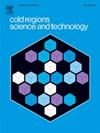雨雪屋顶附加荷载:对近期坍塌、设计标准、当前研究和挑战的回顾
IF 3.8
2区 工程技术
Q1 ENGINEERING, CIVIL
引用次数: 0
摘要
雨雪(ROS)事件可以显著增加建筑物屋顶的雪负荷,特别是保留的雨水增加了积雪的重量。由于气候变化加剧了这种事件,在新旧结构中都观察到最近由活性氧荷载引起的屋顶损坏。评估现有雪荷载规范中的活性氧负荷对于确定它们是否充分应对气候驱动的影响(包括降水模式变化和极端天气事件)至关重要。本文对ROS事件、损害案例、现有方法和气候变化进行了系统综述,并指出积雪、其性质和流动类型是重点关注的领域。对活性氧负荷标准的回顾揭示了对历史数据和积雪特征的依赖,对气候变化对活性氧附加负荷影响的考虑有限。对关键词的文献计量分析表明,建立ROS负荷模型需要考虑环境因素、积雪特性和气候变化效应。在现有的模型中,融雪和积雪模型对长期ROS模拟是有效的,特别是在雪深、密度和孔隙分布方面。相比之下,流动模型可以为估计ROS负荷提供实用的解决方案,同时考虑到旧积雪中均匀和非均匀湿锋流动条件。均匀湿润锋流和基质优先流之间的区别对于确定ROS负荷模型的复杂性至关重要,因为这些模式显著影响雪中的保水性。由于全球变暖会加剧ROS事件,因此必须用气候模型重新评估ROS负荷标准,以了解气候非平稳性的未来影响。本文章由计算机程序翻译,如有差异,请以英文原文为准。
Rain-on-snow roof surcharge load: A review of recent collapses, design standards, current research, and challenges
Rain-on-snow (ROS) events can significantly increase roof snow loads in buildings, particularly as retained rainwater adds to the snowpack's weight. Recent roof damages from ROS load have been observed in both old and new structures, as climate changes exacerbate such events. Evaluating ROS load in existing snow load codes is crucial to determine whether they adequately address climate-driven impacts, including changing precipitation patterns and extreme weather events. This paper presents a systematic review of the ROS events, damage cases, current methods, and changing climate which shows that snowpack, its properties, and flow type are the key areas of focus. The review of ROS load standards exposed a reliance on historical data and snowpack characteristics, with limited consideration of climate change impacts on ROS surcharge loads. The bibliometric analysis of keywords revealed that environmental factors, snowpack properties, and climate change effects need to be considered for modeling ROS load. Among the available models, snowmelt and snowpack models are effective for long-term ROS simulations, particularly regarding snow depth, density, and pore distribution. In contrast, flow models can provide practical solutions for estimating ROS load while accounting for both uniform and non-uniform wetting front flow conditions in older snowpacks. The distinction between uniform wetting front flow and matrix-preferential flow is pivotal in determining the complexity of ROS load models, as these patterns significantly influence water retention in snow. As global warming can intensify ROS events, reassessment of ROS load standards with climate models is imperative to understand the future effects of climate non-stationarity.
求助全文
通过发布文献求助,成功后即可免费获取论文全文。
去求助
来源期刊

Cold Regions Science and Technology
工程技术-地球科学综合
CiteScore
7.40
自引率
12.20%
发文量
209
审稿时长
4.9 months
期刊介绍:
Cold Regions Science and Technology is an international journal dealing with the science and technical problems of cold environments in both the polar regions and more temperate locations. It includes fundamental aspects of cryospheric sciences which have applications for cold regions problems as well as engineering topics which relate to the cryosphere.
Emphasis is given to applied science with broad coverage of the physical and mechanical aspects of ice (including glaciers and sea ice), snow and snow avalanches, ice-water systems, ice-bonded soils and permafrost.
Relevant aspects of Earth science, materials science, offshore and river ice engineering are also of primary interest. These include icing of ships and structures as well as trafficability in cold environments. Technological advances for cold regions in research, development, and engineering practice are relevant to the journal. Theoretical papers must include a detailed discussion of the potential application of the theory to address cold regions problems. The journal serves a wide range of specialists, providing a medium for interdisciplinary communication and a convenient source of reference.
 求助内容:
求助内容: 应助结果提醒方式:
应助结果提醒方式:


